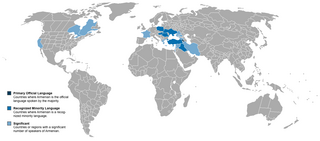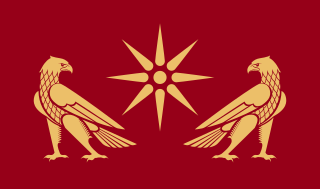
The Armenian language is an Indo-European language that is the only language in the Armenian branch. It is the official language of Armenia as well as the de facto Republic of Artsakh. Historically being spoken throughout the Armenian Highlands, today, Armenian is widely spoken throughout the Armenian diaspora. Armenian is written in its own writing system, the Armenian alphabet, introduced in 405 AD by Mesrop Mashtots.

Gregory the Illuminator is the patron saint and first official head of the Armenian Apostolic Church. He was a religious leader who is credited with converting Armenia from paganism to Christianity in 301. Armenia thus became the first nation to adopt Christianity as its official religion.

Yerevan is the capital and largest city of Armenia as well as one of the world's oldest continuously inhabited cities. Situated along the Hrazdan River, Yerevan is the administrative, cultural, and industrial center of the country. It has been the capital since 1918, the fourteenth in the history of Armenia and the seventh located in or around the Ararat plain. The city also serves as the seat of the Araratian Pontifical Diocese; the largest diocese of the Armenian Apostolic Church and one of the oldest dioceses in the world.

Nagorno-Karabakh, also known as Artsakh, is a landlocked region in the South Caucasus, within the mountainous range of Karabakh, lying between Lower Karabakh and Zangezur, and covering the southeastern range of the Lesser Caucasus mountains. The region is mostly mountainous and forested.

The history of Armenia covers the topics related to the history of Armenia, as well as the Armenian people, the Armenian language, and the regions historically and geographically considered Armenian.

The Armenian Genocide was the systematic mass murder and expulsion of 1.5 million ethnic Armenians carried out in Turkey and adjoining regions by the Ottoman government between 1914 and 1923. The starting date is conventionally held to be 24 April 1915, the day that Ottoman authorities rounded up, arrested, and deported from Constantinople to the region of Angora (Ankara), 235 to 270 Armenian intellectuals and community leaders, the majority of whom were eventually murdered.

The Armenian diaspora refers to the communities of Armenians outside Armenia and other locations where Armenians are considered an indigenous population. Since antiquity, Armenians have established communities in many regions throughout the world. However, the modern Armenian diaspora was largely formed as a result of the WWI, when the Armenian Genocide ordered by the Ottoman Empire forced the people living in their homeland to flee or be killed.

The Armenian Apostolic Church is the national church of the Armenian people. Part of Oriental Orthodoxy, it is one of the most ancient Christian institutions. The Kingdom of Armenia was the first state to adopt Christianity as its official religion under the rule of King Tiridates III in the early 4th century. According to tradition, the church originated in the missions of Apostles Bartholomew and Thaddeus in the 1st century.

Mount Ararat is a snow-capped and dormant compound volcano in the extreme east of Turkey. It consists of two major volcanic cones: Greater Ararat and Little Ararat. Greater Ararat is the highest peak in Turkey and the Armenian Highland with an elevation of 5,137 m (16,854 ft); Little Ararat's elevation is 3,896 m (12,782 ft). The Ararat massif is about 35 km (22 mi) wide at ground base. The first recorded efforts to reach Ararat's summit were made in the Middle Ages, and Friedrich Parrot, Khachatur Abovian, and four others made the first recorded ascent in 1829.

Armenia, officially the Armenian Soviet Socialist Republic, also commonly referred to as Soviet Armenia, was one of the constituent republics of the Soviet Union in December 1922 located in the South Caucasus region of Eurasia. It was established in December 1920, when the Soviets took over control of the short-lived First Republic of Armenia and lasted until 1991. It is sometimes called the Second Republic of Armenia, following the First Republic of Armenia's demise.

Armenians are an ethnic group native to the Armenian Highlands of Western Asia.

The Armenian Catholic Church is one of the Eastern particular churches sui iuris of the Catholic Church. They accept the leadership of the Bishop of Rome, known as the papal primacy, and therefore are in full communion with the Catholic Church, including both the Latin Church and the 22 other Eastern Catholic Churches. The Armenian Catholic Church is regulated by Eastern canon law, namely the Code of Canons of the Eastern Churches.

The Kingdom of Armenia, also the Kingdom of Greater Armenia, or simply Greater Armenia, sometimes referred to as the Armenian Empire, was a monarchy in the Ancient Near East which existed from 321 BC to 428 AD. Its history is divided into successive reigns by three royal dynasties: Orontid, Artaxiad and Arsacid (52–428).

The Republic of Artsakh, or simply Artsakh, also known by its second official name, the Nagorno-Karabakh Republic, is a breakaway de facto state in the South Caucasus that is internationally recognized as part of Azerbaijan. The region is currently populated mostly by Armenians and the primary spoken language is Armenian. Artsakh controls most of the territory of the former Nagorno-Karabakh Autonomous Oblast and some of the surrounding area, giving it a border with Armenia to the west and Iran to the south. Its capital is Stepanakert.

The Armenian Kingdom of Cilicia, also known as Cilician Armenia, Lesser Armenia, or New Armenia and formerly known as the Armenian Principality of Cilicia, was an Armenian state formed during the High Middle Ages by Armenian refugees fleeing the Seljuk invasion of Armenia. Located outside the Armenian Highlands and distinct from the Kingdom of Armenia of antiquity, it was centered in the Cilicia region northwest of the Gulf of Alexandretta.

The Nagorno-Karabakh War was an ethnic and territorial conflict that took place in the late 1980s to May 1994, in the enclave of Nagorno-Karabakh in southwestern Azerbaijan, between the majority ethnic Armenians of Nagorno-Karabakh backed by Armenia, and the Republic of Azerbaijan. As the war progressed, Armenia and Azerbaijan, both former Soviet Republics, entangled themselves in protracted, undeclared mountain warfare in the mountainous heights of Karabakh as Azerbaijan attempted to curb the secessionist movement in Nagorno-Karabakh. The enclave's parliament had voted in favor of uniting itself with Armenia and a referendum, boycotted by the Azerbaijani population of Nagorno-Karabakh, was held, whereby most of the voters voted in favor of independence. The demand to unify with Armenia began in a relatively peaceful manner in 1988; in the following months, as the Soviet Union disintegrated, it gradually grew into an increasingly violent conflict between Armenians and Azerbaijanis, resulting in ethnic cleansing, with Sumgait pogrom (1988), Baku pogrom (1990) and Khojaly Massacre (1992) being notable examples.
Armenian Americans are citizens or residents of the United States who have total or partial Armenian ancestry. They form the second largest community of the Armenian diaspora after Armenians in Russia. The first major wave of Armenian immigration to the United States took place in the late nineteenth and early twentieth centuries. Thousands of Armenians settled in the United States following the Hamidian massacres of the mid-1890s, the Adana Massacre of 1909, and the Armenian Genocide of 1915 in the Ottoman Empire. Since the 1950s many Armenians from the Middle East migrated to America as a result of political instability in the region. It accelerated in the late 1980s and has continued after the dissolution of the Soviet Union in 1991 due to socio-economic and political reasons.

Armenia, officially the Republic of Armenia, is a landlocked country in the South Caucasus region of Eurasia. Located in Western Asia, on the Armenian Highlands, it is bordered by Turkey to the west, Georgia to the north, the de facto independent Republic of Artsakh and Azerbaijan to the east, and Iran and Azerbaijan's exclave of Nakhchivan to the south.
The Armenian alphabet is an alphabetic writing system used to write Armenian. It was developed around 405 AD by Mesrop Mashtots, an Armenian linguist and ecclesiastical leader. The system originally had 36 letters; eventually, three more were adopted. The alphabet was also in wide use in the Ottoman Empire around the 18th and 19th centuries.

The ongoing worldwide 2019–20 coronavirus pandemic was confirmed to have reached Armenia on 1 March 2020 when its first case was confirmed. The disease, coronavirus disease 2019, caused by a novel virus known as severe acute respiratory syndrome coronavirus 2, has spread to all of the regions (marz) of Armenia, except for Gegharkunik, and has caused 18 deaths.
















